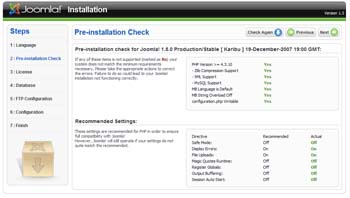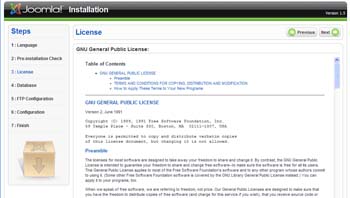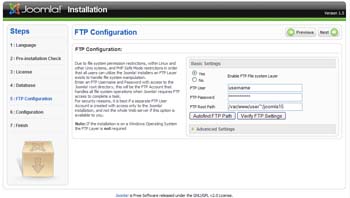Difference between revisions of "Installer"
From Joomla! Documentation
(New page: {{in use}}) |
m (done) |
||
| (43 intermediate revisions by 8 users not shown) | |||
| Line 1: | Line 1: | ||
| − | + | ===Using the the Joomla! Installer=== | |
| + | Once your files have been uploaded to the hosting space using an [[Using_an_FTP_client_to_upload_files|FTP client]], it is time to install Joomla!. | ||
| + | |||
| + | First open an Internet Browser and type in the address of your new Joomla! website. For example: | ||
| + | |||
| + | <source lang="html4strict">yourdomain.com</source> or if you are running from your local server, type: | ||
| + | <source lang="html4strict"> http://localhost/name-of-your-joomla-site </source> | ||
| + | |||
| + | If you are planning to install and use Joomla! on your personal computer then refer to [[J2.5:Use_Joomla!_on_your_own_computer|here]]. | ||
| + | |||
| + | |||
| + | '''Screen 1:''' | ||
| + | After the correct address is entered, the image below will appear. Joomla! has redirected you to the /installation subdirectory. In this step you can choose the default language (English) or anyother one. | ||
| + | |||
| + | [[Image:Installer_Lang.jpg]] | ||
| + | |||
| + | |||
| + | '''Screen 2:''' | ||
| + | Click 'Next' and Joomla! displays the Pre-Installation Checklist. Specific details relating to PHP settings are outlined here. To proceed with the installation, all the lights should be green and set to Yes. | ||
| + | |||
| + | [[Image:Installer_PreCheck.jpg]] | ||
| + | |||
| + | '''Explanation about terms:''' (TECHNICAL REVIEW NEEDED OF THIS EXPLANATION) (Links to definitions were put on the terms) | ||
| + | |||
| + | *[http://www.php.net/manual/en/intro-whatis.php PHP] version must be 4.3.10 or greater than 4.3.10 | ||
| + | *[http://www.zlib.net/ Zlib Compression] Support | ||
| + | *[http://www.xml.com/pub/a/98/10/guide0.html?page=2#AEN58 XML] support | ||
| + | *[http://www.mysql.com/about/ MySQL] support | ||
| + | *[http://en.wikipedia.org/wiki/UTF-8#Description MB Language (Multibyte Language)] is Default | ||
| + | *[http://www.php.net/manual/en/mbstring.overload.php MB String Overload] Off | ||
| + | *Writable configuration.php | ||
| + | |||
| + | '''Recommended settings for the actual column:''' | ||
| + | |||
| + | *Safe Mode is off | ||
| + | *Display Errors is on | ||
| + | *File Uploads is on | ||
| + | *Magic Quotes Runtime is off | ||
| + | *Register Globals is off | ||
| + | *Output Buffering is off | ||
| + | *Session Auto Start is off | ||
| + | |||
| + | |||
| + | '''Screen 3:''' | ||
| + | Click 'Next' and the licence prompt below will appear.[[wikipedia:GNU/GPL|GNU/GPL]] | ||
| + | |||
| + | [[Image:Installer_GNUGPL.jpg]] | ||
| + | |||
| + | |||
| + | '''Screen 4:''' | ||
| + | Click 'Next' to enter the Database configurations. Guidelines are provided on the right-hand side to assist in completing the text fields properly. Please note that all data must be entered correctly to avoid errors. The fields to fill are: | ||
| + | *Host name: | ||
| + | *Username: | ||
| + | *Password: | ||
| + | *Database name: | ||
| + | |||
| + | Note that you need to create a database. This can be done through your MySQL manager in your webhost or through the default phpMyAdmin application on WAMP(Windows, Apache, MySQL, PHP) server application. Databases created through your web host usually take 15-20 minutes to set up so it is best so set them up while you are transferring files to your server rather than waiting until this step. | ||
| + | |||
| + | [[Image:Installer_Database.jpg]] | ||
| + | |||
| + | |||
| + | '''Screen 5:''' | ||
| + | Click 'Next' to enter the FTP settings. This allows Joomla! to operate in a more secure way, eliminating the need for PHP to handle file upload requests. Note: The FTP layer is not necessary but advised for additional site security. | ||
| + | |||
| + | [[Image:Installer_FTP.jpg]] | ||
| + | |||
| + | |||
| + | '''Screen 6:''' | ||
| + | Click 'Next' to enter the Main Configuration details. Here you fill in | ||
| + | *Site name: | ||
| + | *Your E-mail: | ||
| + | *Admin password: | ||
| + | *Confirm admin password: | ||
| + | |||
| + | Notice: To install sample data (modules, articles, sections, categories) you can press the install sample data button before you click the next step. This will give you a functional Joomla! site with pre-populated content to work from. | ||
| + | |||
| + | [[Image:Installer_MainConfig.jpg]] | ||
| + | |||
| + | |||
| + | '''Screen 7:''' | ||
| + | Click 'Next' and a warning to delete the installation directory will appear. Once that is done (most likely using [[Using_an_FTP_client_to_upload_files|FTP client]], click either the 'View Site' tab or the 'Administrator' tab to continue using Joomla!. | ||
| + | |||
| + | [[Category:Archived pages]] | ||
Latest revision as of 18:42, 23 March 2017
This page has been archived. This page contains information for an unsupported Joomla! version or is no longer relevant. It exists only as a historical reference, it will not be improved and its content may be incomplete and/or contain broken links.
Using the the Joomla! Installer[edit]
Once your files have been uploaded to the hosting space using an FTP client, it is time to install Joomla!.
First open an Internet Browser and type in the address of your new Joomla! website. For example:
yourdomain.comor if you are running from your local server, type:
http://localhost/name-of-your-joomla-siteIf you are planning to install and use Joomla! on your personal computer then refer to here.
Screen 1:
After the correct address is entered, the image below will appear. Joomla! has redirected you to the /installation subdirectory. In this step you can choose the default language (English) or anyother one.
Screen 2:
Click 'Next' and Joomla! displays the Pre-Installation Checklist. Specific details relating to PHP settings are outlined here. To proceed with the installation, all the lights should be green and set to Yes.
Explanation about terms: (TECHNICAL REVIEW NEEDED OF THIS EXPLANATION) (Links to definitions were put on the terms)
- PHP version must be 4.3.10 or greater than 4.3.10
- Zlib Compression Support
- XML support
- MySQL support
- MB Language (Multibyte Language) is Default
- MB String Overload Off
- Writable configuration.php
Recommended settings for the actual column:
- Safe Mode is off
- Display Errors is on
- File Uploads is on
- Magic Quotes Runtime is off
- Register Globals is off
- Output Buffering is off
- Session Auto Start is off
Screen 3:
Click 'Next' and the licence prompt below will appear.GNU/GPL
Screen 4:
Click 'Next' to enter the Database configurations. Guidelines are provided on the right-hand side to assist in completing the text fields properly. Please note that all data must be entered correctly to avoid errors. The fields to fill are:
- Host name:
- Username:
- Password:
- Database name:
Note that you need to create a database. This can be done through your MySQL manager in your webhost or through the default phpMyAdmin application on WAMP(Windows, Apache, MySQL, PHP) server application. Databases created through your web host usually take 15-20 minutes to set up so it is best so set them up while you are transferring files to your server rather than waiting until this step.
Screen 5:
Click 'Next' to enter the FTP settings. This allows Joomla! to operate in a more secure way, eliminating the need for PHP to handle file upload requests. Note: The FTP layer is not necessary but advised for additional site security.
Screen 6:
Click 'Next' to enter the Main Configuration details. Here you fill in
- Site name:
- Your E-mail:
- Admin password:
- Confirm admin password:
Notice: To install sample data (modules, articles, sections, categories) you can press the install sample data button before you click the next step. This will give you a functional Joomla! site with pre-populated content to work from.
Screen 7:
Click 'Next' and a warning to delete the installation directory will appear. Once that is done (most likely using FTP client, click either the 'View Site' tab or the 'Administrator' tab to continue using Joomla!.





